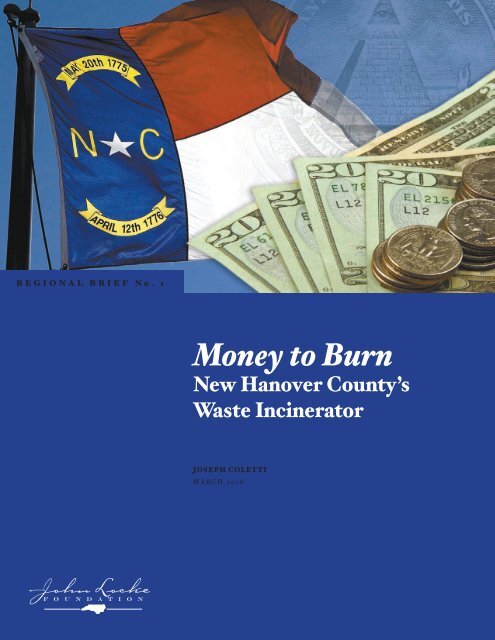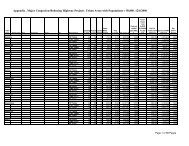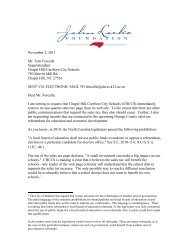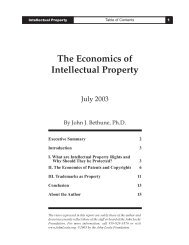Money to Burn - John Locke Foundation
Money to Burn - John Locke Foundation
Money to Burn - John Locke Foundation
Create successful ePaper yourself
Turn your PDF publications into a flip-book with our unique Google optimized e-Paper software.
R E G I O N A L B R I E F N o . 1<br />
<strong>Money</strong> <strong>to</strong> <strong>Burn</strong><br />
New Hanover County’s<br />
Waste Incinera<strong>to</strong>r<br />
JOSEPH COLET TI<br />
M A RC H 2 0 0 6
m o n e y t o b u r n | new hanover county’s wastec incinera<strong>to</strong>r<br />
<strong>Money</strong> <strong>to</strong> <strong>Burn</strong><br />
New Hanover County’s<br />
WASTEC Incinera<strong>to</strong>r<br />
Joseph Coletti<br />
March 2006<br />
Table of Contents<br />
2 Executive Summary<br />
3 Introduction<br />
3 His<strong>to</strong>ry of Landfill and WASTEC<br />
5 Cost and Competition<br />
6 It Doesn’t Take a System<br />
8 More Efficient Use of Landfill Space<br />
9 Conclusion<br />
11 Notes<br />
The views expressed in this report are solely those of the author and do not necessarily<br />
reflect those of the staff or board of the <strong>John</strong> <strong>Locke</strong> <strong>Foundation</strong>. For more information,<br />
call 919-828-3876 or visit www.<strong>John</strong><strong>Locke</strong>.org ©2006 by <strong>John</strong> <strong>Locke</strong> <strong>Foundation</strong>.<br />
r e g i o n a l b r i e f
m o n e y t o b u r n | new hanover county’s wastec incinera<strong>to</strong>r<br />
exeCutive summary<br />
New Hanover County built its waste-<strong>to</strong>energy<br />
incinera<strong>to</strong>r (WASTEC) as a result<br />
of the difficulty the county had in the late<br />
1970s with landfills. County officials wanted<br />
<strong>to</strong> make sure the new landfill built in 1981<br />
would be able <strong>to</strong> last and saw incineration<br />
as a moneymaking way <strong>to</strong> do that.<br />
WASTEC was expected <strong>to</strong> earn enough<br />
from energy sales for the county <strong>to</strong> eliminate<br />
solid waste tipping fees. Energy prices<br />
began <strong>to</strong> plummet in 1983 and remained<br />
below his<strong>to</strong>ric averages for most of the<br />
next fifteen years. Tipping fees rose as high<br />
as $60 per <strong>to</strong>n and the waste management<br />
system has only been able <strong>to</strong> break even<br />
since fiscal year 2003 with a $46 per <strong>to</strong>n<br />
tipping fee.<br />
It may have made sense at the time, but<br />
WASTEC has never lived up <strong>to</strong> its promise<br />
and it is time for the county <strong>to</strong> write off<br />
this failed experiment.<br />
The New Hanover County Department<br />
of Environmental Management delayed<br />
numerous ways <strong>to</strong> improve efficiency at its<br />
landfill for fifteen years or more, perhaps<br />
unintentionally, while it focused efforts on<br />
managing WASTEC.<br />
J o h n l o c k e f o u n d a t i o n<br />
Some of these steps include:<br />
• Adopt Posi-Shell Cover System,<br />
which would have reduced the amount of<br />
daily cover needed from six inches <strong>to</strong> 1 /4<br />
inch<br />
• Redirect construction and demolition<br />
materials from the landfill<br />
• Introduce recycled leachate liquid <strong>to</strong><br />
the landfill as a way <strong>to</strong> accelerate decomposition<br />
and increase compaction — methane<br />
gas produced can be collected and sold<br />
Without WASTEC, New Hanover<br />
County could reduce tipping fees <strong>to</strong>day or<br />
divert the extra revenue from its $46 tipping<br />
fee <strong>to</strong> the General Fund. If a proposed<br />
private landfill opens in nearby Columbus<br />
County, New Hanover County would not<br />
need <strong>to</strong> impose flow control that keeps<br />
trash going <strong>to</strong> the incinera<strong>to</strong>r. The competing<br />
site could instead help <strong>to</strong> ease the<br />
burden and extend the life of New Hanover<br />
County’s landfill.<br />
Regardless what happens in Columbus<br />
County, New Hanover County’s officials<br />
have nothing <strong>to</strong> lose from the closure of<br />
WASTEC. Whatever costs are involved in<br />
shutting down WASTEC can come from<br />
the same revenue stream that support its<br />
operation now.
introduCtion<br />
New Hanover County has operated a<br />
waste-<strong>to</strong>-energy incinera<strong>to</strong>r (WASTEC)<br />
since 1984. By burning trash, the incinera<strong>to</strong>r<br />
conserves space at the landfill and earns<br />
money for the county through sales of<br />
steam and electricity. New Hanover County’s<br />
Department of Environmental Management<br />
operates the incinera<strong>to</strong>r, a recycling<br />
program and its landfill as a comprehensive<br />
solid waste management system. Critics<br />
argue that the incinera<strong>to</strong>r is simply a waste<br />
of money that provides little benefit <strong>to</strong> the<br />
county. A proposed landfill in Columbus<br />
County could drive tipping fees down and<br />
force New Hanover County <strong>to</strong> reconsider<br />
the value of its comprehensive system.<br />
The first part of this report will examine<br />
the events that led <strong>to</strong> the building of<br />
the incinera<strong>to</strong>r and its operation since. The<br />
second part will look more at the cost of incineration<br />
and the impact of the proposed<br />
Columbus County landfill on solid waste<br />
flows in the region, particularly ending the<br />
ability <strong>to</strong> cross-subsidize WASTEC with<br />
earnings from the landfill. The third part<br />
will compare the services approach taken<br />
by New Hanover County with the capacity<br />
approach taken by landfill opera<strong>to</strong>rs. Here<br />
we find that few of the services offered by<br />
the county rely on WASTEC. The final part<br />
of the report offers some conclusions about<br />
the positive steps that the Department of<br />
Environmental Management has taken <strong>to</strong><br />
make the landfill last longer and a recommendation<br />
that builds on these steps <strong>to</strong><br />
improve the waste management system.<br />
his<strong>to</strong>ry of landfill and WasteC<br />
When New Hanover County tried in 1978<br />
<strong>to</strong> expand its five-year-old Fleming<strong>to</strong>n<br />
landfill, county officials ran in<strong>to</strong> a seemingly<br />
insurmountable set of problems. First,<br />
a neighbor complained that the landfill<br />
contaminated groundwater. State officials<br />
issued a preliminary permit for expansion,<br />
m o n e y t o b u r n | new hanover county’s wastec incinera<strong>to</strong>r<br />
but testing revealed that the groundwater<br />
source for 44 nearby wells was contaminated.<br />
1 Years of further investigation eventually<br />
found that the landfill did not cause<br />
the contamination, but <strong>to</strong>o late <strong>to</strong> have any<br />
effect on landfill decisions.<br />
Unable <strong>to</strong> expand, New Hanover County<br />
had <strong>to</strong> close the Fleming<strong>to</strong>n landfill in<br />
1979 when it reached capacity, leading <strong>to</strong> a<br />
two-year search for a permanent replacement.<br />
The first move was <strong>to</strong> an abandoned<br />
landfill near Carolina Beach, on land controlled<br />
by the Army Corps of Engineers.<br />
County officials <strong>to</strong>ok out a one-year lease<br />
while it studied alternative sites for a new<br />
landfill within its borders. The search was<br />
fruitless, and the county could only get one<br />
90-day extension before the Corps closed<br />
the gates.<br />
In 1980, county officials opened another<br />
temporary facility on Blue Clay Road and<br />
obtained space at the Waste Industries<br />
landfill 68 miles away in Sampson County.<br />
The county still needed a permanent home<br />
for its trash and tried <strong>to</strong> find it in other<br />
counties. Uncooperative commissioners in<br />
13 nearby counties responded by passing<br />
ordinances that barred New Hanover from<br />
condemning land for a landfill within their<br />
borders. The General Assembly later endorsed<br />
these ordinances in state law.<br />
Forced <strong>to</strong> locate inside the county,<br />
New Hanover opened its new $3.2 million<br />
landfill on US Highway 421 in November<br />
1981. County officials, who were frustrated<br />
by the difficult and lengthy process, also<br />
explored ways <strong>to</strong> make the landfill last<br />
longer. High energy prices at the time led<br />
them <strong>to</strong> think a waste-<strong>to</strong>-energy incinera<strong>to</strong>r<br />
would “increase the design life of the New<br />
Hanover County Landfill by a fac<strong>to</strong>r of four<br />
… <strong>to</strong> 150 years.” 2 Energy sales would help<br />
keep tipping fees low and possibly allow the<br />
county <strong>to</strong> eliminate the fees.<br />
The incinera<strong>to</strong>r opened in September<br />
1984 at a cost of $14 million, including $10<br />
r e g i o n a l b r i e f
m o n e y t o b u r n | new hanover county’s wastec incinera<strong>to</strong>r<br />
million in voter-approved general obligation<br />
bonds. In 1990, the County issued another<br />
$29 million in bonds in 1990 <strong>to</strong> pay for an<br />
expansion of the plant. Debt service on the<br />
bonds was $7.9 million in fiscal year 2004-<br />
2005. 3<br />
Far from eliminating the tipping<br />
fee, however, WASTEC’s costs have led<br />
the county <strong>to</strong> raise fees. The tipping fee<br />
reached $60 per <strong>to</strong>n in fiscal year (FY) 1992<br />
before competition from a Waste Management<br />
transfer station outside the county<br />
forced a return <strong>to</strong> $25 per <strong>to</strong>n in FY 1994. It<br />
bounced up and down around $30 per <strong>to</strong>n<br />
over the next few years until, in FY 2003,<br />
the county raised the tipping fee from $32<br />
per <strong>to</strong>n <strong>to</strong> $46 per <strong>to</strong>n. County officials also<br />
signed a seven-year franchise agreement<br />
with private haulers <strong>to</strong> guarantee volume<br />
for the incinera<strong>to</strong>r and the county land-<br />
J o h n l o c k e f o u n d a t i o n<br />
Figure 1: Municipal Waste Incinera<strong>to</strong>rs in North Carolina, 1990-2002<br />
Source: N.C. Dept. of Environment and Natural Resources, Division of Waste Management<br />
fill. These two steps made the entire solid<br />
waste management system self-funding,<br />
eliminated the costly general fund subsidy<br />
<strong>to</strong> WASTEC, and improved the county’s<br />
bond rating from Fitch <strong>to</strong> AA in 2005. 4<br />
WASTEC has been the only municipal<br />
solid waste incinera<strong>to</strong>r in the state for<br />
nearly a decade (see Figure 1). Others were<br />
opened, including one in Wrightsville<br />
Beach, but all of them eventually closed. At<br />
the same time, public and private landfills<br />
have become an important industry for a<br />
number of small, rural communities. All but<br />
six of North Carolina’s 100 counties ship<br />
some or all of their municipal solid waste<br />
out of county or out of state. 5 Five large private<br />
landfills may open in North Carolina,<br />
including one in nearby Columbus County.<br />
When opened, this landfill could provide<br />
New Hanover County with landfill space at
$2,902,519<br />
-$3,928,347<br />
Landfill<br />
WASTEC<br />
Net Surplus/Deficit<br />
-$1,025,828<br />
$1,389,472<br />
competitive prices. This will make it difficult<br />
<strong>to</strong> continue using extra revenue from<br />
the landfill <strong>to</strong> cover costs at WASTEC.<br />
Cost and Competition<br />
Solid waste incineration makes sense in<br />
Europe and Japan where land is scarce. It<br />
makes less sense in a state such as North<br />
Carolina where land is relatively abundant.<br />
That WASTEC is the last municipal solid<br />
waste incinera<strong>to</strong>r in North Carolina and<br />
that five large landfills are planned for the<br />
state reflect this economic fact.<br />
When the landfill and WASTEC first<br />
opened in 1984, the tipping fee was $25 per<br />
<strong>to</strong>n. “In the 1980s, landfill fees were projected<br />
<strong>to</strong> reach $50 or higher by the year<br />
2000—high enough <strong>to</strong> help solid waste<br />
incineration and aggressive recycling programs<br />
compete as serious management<br />
alternatives,” according <strong>to</strong> a North Carolina<br />
Division of Waste Management 2003<br />
his<strong>to</strong>rical review. 6<br />
New Hanover County’s Environmental<br />
Management officials also expected fuel<br />
prices <strong>to</strong> continue <strong>to</strong> rise enough that the<br />
incinera<strong>to</strong>r would be profitable and the<br />
county would even be able <strong>to</strong> eliminate the<br />
Figure 2: Surplus or Deficit by Facility<br />
-$4,301,186<br />
-$5,690,658<br />
$417,960<br />
-$4,238,609<br />
m o n e y t o b u r n | new hanover county’s wastec incinera<strong>to</strong>r<br />
-$3,820,649<br />
$3,666,961<br />
$1,669,794<br />
-$1,997,167<br />
$6,408,140<br />
$1,004,799<br />
-$5,403,341<br />
FY2000 FY2001 FY2002 FY2003 FY2004<br />
Source: New Hanover County Comprehensive Annual Financial Reports FY2000–FY2004<br />
tipping fee. Oil prices had already started<br />
<strong>to</strong> collapse by the time WASTEC opened<br />
in 2004 and rarely exceed $20 per barrel<br />
until 2000. 7 This left energy sales from the<br />
plant running below expectations and no<br />
chance <strong>to</strong> eliminate or even lower the tipping<br />
fee.<br />
Instead New Hanover County had <strong>to</strong><br />
increase the tipping fee. The county tipping<br />
fee reached $60 in the early 1990s,<br />
compared <strong>to</strong> a state average in the low $20<br />
range. 8 The firm Waste Management, Inc.,<br />
one of the haulers that serves New Hanover<br />
County, responded by building a transfer<br />
station outside the county and began <strong>to</strong><br />
divert some solid waste it collected in New<br />
Hanover County through that transfer station<br />
<strong>to</strong> other landfills. To keep waste from<br />
the county in the county, the Department<br />
of Environmental Management cut the tipping<br />
fee back <strong>to</strong> $25 after two years. Lower<br />
tipping fees, however, left WASTEC’s net<br />
costs as much as $4 million ahead of the<br />
net revenue from the landfill, so the entire<br />
solid waste management system was not<br />
self-sufficient and had <strong>to</strong> rely on subsidies<br />
from the General Fund (see Figure 2).<br />
This pattern continued until FY 2003<br />
r e g i o n a l b r i e f
m o n e y t o b u r n | new hanover county’s wastec incinera<strong>to</strong>r<br />
when county officials<br />
raised the tipping fee <strong>to</strong><br />
$46 per <strong>to</strong>n. The new fee<br />
helped the solid waste<br />
management system<br />
break even for the first<br />
time since the new landfill<br />
opened (see Figure<br />
3). High fuel costs now<br />
make shipping waste <strong>to</strong><br />
the private landfill in<br />
Sampson County less<br />
attractive even though it<br />
has a significantly lower<br />
tipping fee.<br />
Since the county<br />
introduced the $46 tipping<br />
fee in FY2003, its<br />
waste management system has been able<br />
<strong>to</strong> break even, posting small returns as a<br />
whole. The $6.5 million net revenue it earns<br />
at the landfill now offsets the $5.5 million<br />
extra (net of energy sales) it spends <strong>to</strong> process<br />
waste through the incinera<strong>to</strong>r. Because<br />
of this balance, New Hanover County no<br />
longer has <strong>to</strong> divert millions of dollars<br />
from the general fund each year <strong>to</strong> cover<br />
WASTEC’s losses<br />
The $46 tipping fee is only sustainable<br />
as long as transportation costs remain high<br />
and until a proposed Waste Management,<br />
Inc., landfill opens in Columbus County.<br />
If approved and built, competition from<br />
this project will force tipping fees lower<br />
throughout the region.<br />
A new landfill with lower prices will<br />
compel more efficient operations at all<br />
existing facilities or systems. This is a<br />
daunting challenge for others in the landfill<br />
business, such as the Waste Industries landfill<br />
in Sampson County. It becomes almost<br />
impossible for those who use net revenues<br />
from their landfill <strong>to</strong> subsidize more costly<br />
alternatives, such as recycling and incineration.<br />
Even before that happens, however, the<br />
J o h n l o c k e f o u n d a t i o n<br />
Figure 3: New Hanover Co.’s Solid Waste Net Surplus (Deficit)<br />
Figure 3: New Hanover County Net Surplus (Deficit)<br />
$2,000,000<br />
$1,000,000<br />
$0<br />
($1,000,000)<br />
($2,000,000)<br />
($3,000,000)<br />
($4,000,000)<br />
($5,000,000)<br />
($6,000,000)<br />
198319851987198919911993199519971999200120032005<br />
Source: New Hanover County Finance Office<br />
county is still burning money at WASTEC.<br />
Closing the incinera<strong>to</strong>r will allow the county<br />
either <strong>to</strong> reduce the tipping fee or <strong>to</strong> use<br />
the proceeds for other county services.<br />
Given the paucity of energy sales from<br />
the incinera<strong>to</strong>r and the apparent need for<br />
higher tipping fees, why did the county issue<br />
new debt <strong>to</strong> expand WASTEC instead<br />
of shutting the plant down in FY 1993?<br />
Why does it continue <strong>to</strong> support WASTEC<br />
<strong>to</strong>day? Because New Hanover County environment<br />
officials do not think the incinera<strong>to</strong>r<br />
was distinct from the landfill. In their<br />
minds, the two are part of an integrated<br />
system with recycling that cannot be broken<br />
up, like Ike and Tina.<br />
it doesn’t take a system<br />
“The private sec<strong>to</strong>r sells landfill space,” said<br />
Ray Church, Direc<strong>to</strong>r of the New Hanover<br />
County Department of Environmental<br />
Management. “The only concern is capacity<br />
— not environment, not systems, just<br />
capacity.” Church argues that the county<br />
helps the environment and residents because<br />
it provides recycling, incineration and<br />
landfill services in an integrated solid waste<br />
system.
Most of the services the<br />
county provides, however, do<br />
not depend on it actually owning<br />
a recycling center or incinera<strong>to</strong>r,<br />
and some would be<br />
easier <strong>to</strong> provide in a landfillonly<br />
environment. Hurricane<br />
clean-up, an important service<br />
in New Hanover County, involves<br />
a great deal of energy <strong>to</strong><br />
dry the saturated waste before<br />
it can burn. This process can<br />
consume more energy than it<br />
produces, which is not a good<br />
way for a power plant <strong>to</strong> operate.<br />
It is more economical for<br />
spoiled food and other waste<br />
from future hurricanes <strong>to</strong> go<br />
directly <strong>to</strong> the county landfill<br />
or another regional landfill.<br />
Since the county began<br />
diverting construction and demolition<br />
materials in 2003, it has done this at the<br />
landfill. Glass and cardboard could also be<br />
separated there, instead of at WASTEC.<br />
When New Hanover County began<br />
diverting construction and demolition<br />
waste from its landfill, it could increase<br />
compression rates, which extends the life of<br />
each cell and the entire landfill. Because the<br />
county has a contract with a private firm<br />
<strong>to</strong> purchase the construction and demolition<br />
materials, it also earns money from the<br />
diversion.<br />
It also earns money by separating glass<br />
and cardboard for recycling. Plastic, however,<br />
costs more <strong>to</strong> recycle than the price paid<br />
by the market. Recycling as a whole is also<br />
more expensive than other forms of disposal<br />
for the county because the recycling<br />
program is responsible for its own collection<br />
– a service that is not included in the<br />
costs of the landfill or WASTEC because it<br />
is contracted out <strong>to</strong> private companies, but<br />
which accounts for 75 percent of recycling<br />
cost.<br />
m o n e y t o b u r n | new hanover county’s wastec incinera<strong>to</strong>r<br />
Sidebar: Flow Control<br />
Flow control is a way <strong>to</strong> force municipal solid waste<br />
<strong>to</strong> certain facilities, which makes higher tipping fees<br />
possible. Governments have had the option <strong>to</strong> impose<br />
flow control on municipal solid waste, but New Hanover<br />
County’s ability <strong>to</strong> use this <strong>to</strong>ol may be limited<br />
due <strong>to</strong> a series of court rulings. First was a 1994<br />
Supreme Court decision that broadly declared such<br />
controls unconstitutional (C & A Carbone, Inc. v. Clark<br />
s<strong>to</strong>wn 9 ). A 2001 Second Circuit court of appeals decision<br />
(United Haulers Association, Inc. v. Oneida-Herkimer<br />
Solid Waste Mgmt. Authority) made some allowance for<br />
flow controls as applied <strong>to</strong> publicly owned disposal facilities.<br />
10 But a Sixth Circuit court decision in January<br />
2006 (NSWMA v. Daviess County) specifically rejected<br />
“the Second Circuit on the proposition that Carbone<br />
lends support for the public-private distinction drawn<br />
by that court.” 11<br />
These activities do not rely on<br />
WASTEC or its 60-person workforce.<br />
While the landfill operates with a handful<br />
of full-time employees plus a score of parttime<br />
and temporary workers, WASTEC has<br />
60 technical jobs <strong>to</strong> run the heavy machinery<br />
and complex systems of the power<br />
plant.<br />
WASTEC is always open, in part because<br />
it costs more <strong>to</strong> shut down and<br />
restart the facility than <strong>to</strong> keep it running.<br />
The New Hanover County landfill, like<br />
most landfills, is open five or six days a<br />
week. The continuous operation of the incinera<strong>to</strong>r<br />
is convenient <strong>to</strong> haulers who can<br />
dump waste at any time of day or night, but<br />
the tipping fee for the landfill is the same<br />
$46 as the fee for WASTEC. Apparently<br />
the convenience of midnight tipping is not<br />
worth a premium.<br />
The problem with a single tipping fee,<br />
which we assume is what the market will<br />
bear, is that costs are not the same. Even<br />
with the incinera<strong>to</strong>r available 24 hours a<br />
day, every day, it cost the county $72.69<br />
r e g i o n a l b r i e f
m o n e y t o b u r n | new hanover county’s wastec incinera<strong>to</strong>r<br />
per <strong>to</strong>n or more because of its high staffing<br />
needs and other expenses. The highest cost<br />
per <strong>to</strong>n at the landfill was $21.80 in fiscal<br />
year 2000-2001 (Figure 4). The tipping<br />
fee was always somewhere between these<br />
two extremes. In other words, the county<br />
earned money with each <strong>to</strong>n disposed at<br />
the landfill but lost money with each <strong>to</strong>n<br />
disposed at the incinera<strong>to</strong>r. Higher volumes<br />
at the incinera<strong>to</strong>r spread the capital cost<br />
and lowered the cost per <strong>to</strong>n, but lower<br />
volumes due <strong>to</strong> maintenance meant higher<br />
cost per <strong>to</strong>n.<br />
more effiCient use of landfill spaCe<br />
One benefit of using landfill space is the<br />
ability <strong>to</strong> focus on one set of costs. It<br />
encourages stewardship of the precious resource<br />
called airspace. Closing a section of<br />
a landfill, called a cell, costs money. Opening<br />
a cell costs money. The longer a landfill<br />
opera<strong>to</strong>r can go between closing and<br />
opening cells, the longer it can avoid those<br />
capital costs.<br />
J o h n l o c k e f o u n d a t i o n<br />
Figure 4: Cost Per Ton vs. Tipping Fee (CAFR)<br />
Figure 4: Cost per <strong>to</strong>n vs. Tipping Fee (CAFR)<br />
FY2000 FY2001 FY2002 FY2003 FY2004<br />
WASTEC $80.81 $93.81 $85.16 $72.69 $126.58<br />
Total $36.54 $52.12 $46.09 $43.90 $44.10<br />
Tipping Fee $28.00 $32.00 $32.00 $46.00 $46.00<br />
Landfill $8.81 $21.80 $20.05 $13.65 $11.18<br />
Source: New Hanover County Finance Office<br />
Incineration can reduce the volume of<br />
waste in the landfill by up <strong>to</strong> 85 percent, but<br />
it does not eliminate the need for a landfill.<br />
The ash must still be deposited somewhere.<br />
For this reason, critics of the incinera<strong>to</strong>r<br />
say the ash should be subtracted from the<br />
<strong>to</strong>nnage calculations at the incinera<strong>to</strong>r,<br />
which would increase the incinera<strong>to</strong>r’s cost<br />
per <strong>to</strong>n. New Hanover County claims that<br />
this ash should not count as taking landfill<br />
volume because it replaces soil as ground<br />
cover.<br />
An alternative <strong>to</strong> ash or soil is the Posi-<br />
Shell Cover System, a spray-on slurry that<br />
dries <strong>to</strong> a quarter-inch hard cover instead<br />
of six inches of ash or soil. 12 Orange County<br />
has used Posi-Shell since fiscal year 1994-95.<br />
In December 2000, the county reported<br />
saving about $2,000 of space each day with<br />
Posi-Shell. New Hanover County did not<br />
start using Posi-Shell until 2002 13 and the<br />
Department of Environmental Management<br />
still hopes <strong>to</strong> mix incinera<strong>to</strong>r ash in<strong>to</strong><br />
the Posi-Shell slurry.
Another way <strong>to</strong> extend the life of a<br />
landfill is <strong>to</strong> recycle the liquid “leachate”<br />
back in<strong>to</strong> the fill. This method speeds the<br />
degradation of trash and also helps remove<br />
the volatile organic compounds from both<br />
the trash and the liquid. As this happens,<br />
the landfill produces more methane. This<br />
gas can be captured and piped <strong>to</strong> power<br />
industries around the landfill as well, providing<br />
another source of revenue for the<br />
landfill. In addition, the more rapid degradation<br />
helps compact the trash further.<br />
Despite these advances in prolonging<br />
the useful life of the landfill, and the<br />
county’s claim that its system is not just<br />
about space, one of the most persistent and<br />
prominent arguments for the WASTEC<br />
waste-<strong>to</strong>-energy incinera<strong>to</strong>r is that it reduces<br />
the volume used at the New Hanover<br />
County municipal landfill, and so extends<br />
the landfill’s life.<br />
In the last five years, the City of Wilming<strong>to</strong>n<br />
and private citizens commissioned<br />
studies of the landfill’s remaining life. Each<br />
study extended the life of the current<br />
landfill further in<strong>to</strong> the future, even without<br />
consideration of the adjacent parcel<br />
which is of equal land area but has not been<br />
surveyed <strong>to</strong> determine how much volume<br />
it can hold. The Department of Environmental<br />
Management has started taking<br />
active steps <strong>to</strong> extend the landfill’s life and<br />
now estimates the surveyed section will last<br />
another 20 years.<br />
In June 2002, William Dreitzler, an<br />
engineer with the Raleigh firm Marlowe,<br />
Dreitzler & Associates, at the request of a<br />
New Hanover citizen, David Carnell, used<br />
available data <strong>to</strong> calculate a conservative<br />
estimate of nine years (through 2011) of<br />
life for the surveyed section of the landfill.<br />
14 Hazen and Sawyer, an environmental<br />
engineering firm specializing in solid waste<br />
management, then produced an evaluation<br />
of the landfill and incinera<strong>to</strong>r for the City<br />
m o n e y t o b u r n | new hanover county’s wastec incinera<strong>to</strong>r<br />
of Wilming<strong>to</strong>n in February 2003. Under the<br />
estimates in this report the landfill, including<br />
additional height, would be full between<br />
2009 and 2014. 15<br />
In a memo <strong>to</strong> Hazen and Sawyer’s <strong>John</strong><br />
Bove dated April 14, 2003, New Hanover<br />
County Direc<strong>to</strong>r of Environmental Management<br />
Ray Church complained that the<br />
Hazen and Sawyer report did not consider<br />
a number of improvements in space management<br />
and use at the landfill that had<br />
either been recently introduced or were<br />
under consideration at the time, including<br />
using the Posi-Shell cover system. 16 Bove<br />
responded that the firm’s estimate was also<br />
conservative and that the county’s actions<br />
were congruent with Hazen and Sawyer’s<br />
recommendations. 17<br />
Church now (February 3, 2006) says<br />
the landfill can last “somewhere in the<br />
neighborhood of 20 years,” but refuses <strong>to</strong><br />
be more specific than that because “some<br />
things are better left vague or someone<br />
hangs there [sic] hat on it like [the 150-year<br />
estimate from 1984].” 18<br />
In short, the landfill is not in danger of<br />
running out of space in the next decade.<br />
When it had <strong>to</strong>, New Hanover County’s<br />
Department of Environmental Management<br />
found ways <strong>to</strong> improve space utilization<br />
at the landfill. A new landfill in Columbus<br />
County would remove the ability <strong>to</strong><br />
cross-subsidize incineration (and recycling)<br />
in New Hanover County, but could help<br />
extend the landfill’s life without WASTEC<br />
or the recycling facility. Tipping fees of<br />
$46 could not be offset by transportation<br />
costs as they are now with the Sampson<br />
County landfill. Flow control laws <strong>to</strong> create<br />
a monopoly seem unlikely <strong>to</strong> survive many<br />
more court challenges. However New Hanover<br />
County officials look at the future of<br />
solid waste management, there can be little<br />
room in that vision for WASTEC.<br />
r e g i o n a l b r i e f
0<br />
m o n e y t o b u r n | new hanover county’s wastec incinera<strong>to</strong>r<br />
ConClusion<br />
In its 2003 report, Hazen and Sawyer<br />
offered recommendations for more efficient<br />
use of the landfill space in New Hanover<br />
County and for ways <strong>to</strong> increase the available<br />
space. The county’s Department of<br />
Environmental Management had already<br />
proposed increasing the <strong>to</strong>p of the landfill<br />
from 100 feet <strong>to</strong> 170 feet. Soon after the<br />
report, New Hanover began diverting construction<br />
and demolition debris from the<br />
landfill for processing at other sites. This<br />
helped improve compaction at the landfill<br />
from 1200 pounds per cubic yard <strong>to</strong> 1600<br />
pounds per cubic yard, about the industry<br />
average. The Department of Environmental<br />
Management is still seeking approval for<br />
the ability <strong>to</strong> recycle the liquid from trash<br />
(leachate) back in<strong>to</strong> the landfill as a way <strong>to</strong><br />
speed decomposition and remove volatile<br />
chemicals from the trash. The increased<br />
volume of methane produced in this process<br />
could be captured for use in nearby<br />
industrial facilities, turning the landfill in<strong>to</strong><br />
a “bioreac<strong>to</strong>r” that naturally converts waste<br />
<strong>to</strong> energy. None of these alternatives is<br />
nearly as expensive as running WASTEC.<br />
It also seems likely that using ash from<br />
WASTEC as an alternative cover slowed<br />
New Hanover County’s adoption of Posi-<br />
Shell for cover. As mentioned earlier, this<br />
could cut the need for ground cover from<br />
six inches per day <strong>to</strong> just a quarter-inch per<br />
day. New Hanover began using Posi-Shell<br />
in 2001, by which time other counties had<br />
been using the system for more than five<br />
years.<br />
The Department of Environmental<br />
J o h n l o c k e f o u n d a t i o n<br />
Management considers solid waste management<br />
for New Hanover County as an<br />
indivisible system, rather than as a business<br />
with different operations, each of which<br />
can be evaluated as a distinct unit. There<br />
is no reason for the county not <strong>to</strong> profit<br />
from its current $46 tipping fee. Without<br />
WASTEC, the county could keep the fee<br />
for now and set aside the surplus earned<br />
from operating the landfill for future needs<br />
or current needs, such as schools and roads,<br />
or it could lower the tipping fee and save<br />
money for residents and businesses. With<br />
WASTEC, the county can make unsubstantiated<br />
claims about helping the environment<br />
and eventually face a crisis when the<br />
Columbus County landfill opens.<br />
New Hanover County has 20 years left<br />
in the current landfill and a large tract of<br />
adjacent land that can house a number of<br />
additional cells. There is little reason <strong>to</strong><br />
expect the adjacent site <strong>to</strong> reach capacity in<br />
less than 20 years after it opens. WASTEC<br />
has already been in operation for 22 years.<br />
It is time <strong>to</strong> acknowledge the nobility of<br />
the experiment, but also <strong>to</strong> acknowledge<br />
that the plant was built for a different future<br />
and that the county now has a number<br />
of more cost-effective ways <strong>to</strong> extend the<br />
life of the landfill.<br />
Finally, there is no sense waiting until<br />
the bonds for WASTEC are paid off. The<br />
sooner WASTEC closes, the sooner county<br />
officials and the Department of Environmental<br />
Management can begin <strong>to</strong> redirect<br />
their energies <strong>to</strong> more productive pursuits.<br />
Joseph Coletti is Fiscal Policy Analyst for the<br />
<strong>John</strong> <strong>Locke</strong> <strong>Foundation</strong>.
notes<br />
1. Gary M. Cannon, “An Analysis of the Decision<br />
Making Process of Solving New Hanover County’s<br />
Solid Waste Disposal Problem,” www.p2pays.org/<br />
ref/24/23588.pdf<br />
2. C. Ed Hil<strong>to</strong>n, Jr., “New Hanover County Resource<br />
Recovery Project,” The Professional Engineer,<br />
Raleigh, N.C., November-December 1984.<br />
3. New Hanover County, 2005 Consolidated Annual<br />
Financial Report, Notes <strong>to</strong> the Basic Statements,<br />
June 30, 2005, p. 69.<br />
4. “Fitch Upgrades New Hanover County, NC GO<br />
Bonds and COPs,” FinanzNachrichten.de, Oct. 8,<br />
2005, http://www.finanznachrichten.de/nachrichten-2005-<br />
08/artikel-5194605.asp<br />
5. Michael Sanera, “Bring Out Your Trash: Wake<br />
County’s Dilemma and Why Solid Waste Markets<br />
Matter,” Spotlight 268, <strong>John</strong> <strong>Locke</strong> <strong>Foundation</strong>:<br />
Raleigh, NC, Oct. 24, 2005, http://www.johnlocke.<br />
org/spotlights/display_s<strong>to</strong>ry.html?id=115<br />
6. An Update of the North Carolina Solid Waste<br />
Management Plan 2003 <strong>to</strong> 2013, North Carolina<br />
Division of Waste Management, Chapter 4, “Facing<br />
Old and New Challenges,” http://www.wastenotnc.<br />
org/swhome/swplanning.htm<br />
7. “Oil Price His<strong>to</strong>ry and Economics,” WTRG<br />
Economics, http://www.wtrg.com/prices.htm<br />
8. “1993 Special Report: North Carolina Solid<br />
m o n e y t o b u r n | new hanover county’s wastec incinera<strong>to</strong>r<br />
Waste Disposal,” North Carolina Division of Waste<br />
Management, January 1994, page 4, www.p2pays.<br />
org/ref/24/23540.pdf<br />
9. http://caselaw.lp.findlaw.com/scripts/getcase.pl?court=u<br />
s&vol=000&invol=U10400<br />
10. National Solid Waste Management Association,<br />
“Flow Control of Solid Wastes,” http://wastec.<br />
isproductions.net/webmodules/webarticles/anmviewer.<br />
asp?a=346<br />
11. http://www.ca6.uscourts.gov/opinions.pdf/06a0035p-<br />
06.pdf<br />
12. “Orange County <strong>to</strong> Demonstrate ‘Posi-Shell’<br />
Landfill Cover Thursday,” Orange County Press<br />
Release, Nov. 14, 2000, http://www.co.orange.nc.us/<br />
OCCLERKS/novdec00prsrls.htm#posi-shell<br />
13. New Hanover Board of Commissioners Meeting,<br />
May 20-21, 2002, www.co.new-hanover.nc.us/CC/<br />
PDF/Minutes/2002/RM05-20-2002.pdf<br />
14. William Dreitzler, report <strong>to</strong> David Carnell, June<br />
7, 2002.<br />
15. <strong>John</strong> Bove, report <strong>to</strong> Steven Bridges for City of<br />
Wilming<strong>to</strong>n, Feb. 25, 2003.<br />
16. Ray Church, memo <strong>to</strong> <strong>John</strong> Bove, April 14,<br />
2003.<br />
17. <strong>John</strong> Bove, e-mail <strong>to</strong> Ray Church, March 17,<br />
2003.<br />
18. Ray Church, e-mail <strong>to</strong> author, Feb. 3, 2006.<br />
r e g i o n a l b r i e f
“ To prejudge other men’s notions<br />
before we have looked in<strong>to</strong> them<br />
is not <strong>to</strong> show their darkness<br />
but <strong>to</strong> put out our own eyes.”<br />
john locke (1632–1704)<br />
Author, Two Treatises of Government and<br />
Fundamental Constitutions of Carolina<br />
200 West Morgan St., #200<br />
Raleigh, NC 27601<br />
V: 919-828-3876<br />
F: 919-821-5117<br />
www.johnlocke.org<br />
info@johnlocks.org










